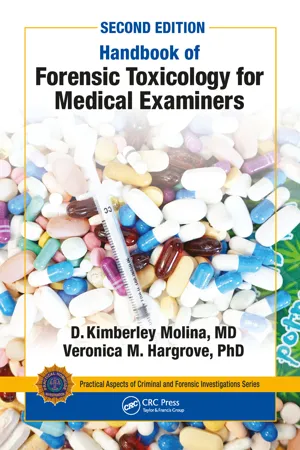
Handbook of Forensic Toxicology for Medical Examiners
- 260 pages
- English
- ePUB (mobile friendly)
- Available on iOS & Android
Handbook of Forensic Toxicology for Medical Examiners
About this book
Forensic professionals, particularly medical examiners—often working through heavy caseloads—require quick and easy access to reliable sources of information to help interpret toxicology results. While several in-depth resources are available, they are often large, cumbersome, and contain more information than is often needed.
The Handbook of Forensic Toxicology for Medical Examiners is a concise handbook referencing the most common toxic substances and their reported non-toxic, toxic, and lethal concentrations, making it an ideal text for quick reference in the lab or autopsy room.
Features of the Second Edition:
- Explains the principles of postmortem toxicology and the factors which must be considered
- Provides tables of toxicologic data for over 200 commonly encountered substances, including drugs of abuse, poisons, prescription drugs, and over-the-counter medications
- Includes discussion and description of the novel psychoactive drugs—including synthetic opioids, cannabinoids, stimulants and hallucinogens
- Supplemental appendices provide additional information regarding specimen types and selection, testing methodologies, normal laboratory values, and conversion charts
The busy forensic professional needs a concise handbook that provides critical information quickly and accurately. This heavily referenced text offers an easy-to-use format allowing for rapid access for both routine daily use and preparation for courtroom testimony.
Frequently asked questions
- Essential is ideal for learners and professionals who enjoy exploring a wide range of subjects. Access the Essential Library with 800,000+ trusted titles and best-sellers across business, personal growth, and the humanities. Includes unlimited reading time and Standard Read Aloud voice.
- Complete: Perfect for advanced learners and researchers needing full, unrestricted access. Unlock 1.4M+ books across hundreds of subjects, including academic and specialized titles. The Complete Plan also includes advanced features like Premium Read Aloud and Research Assistant.
Please note we cannot support devices running on iOS 13 and Android 7 or earlier. Learn more about using the app.
Information
How to Use This Book |
1 |
Special Drug Groups | 2 |
Drugs—Alzheimer’s disease Donepezil (Aricept) Galantamine (Razadyne, Reminyl, Nivalin) Huperzine A Ladostigil Metrifonate Rivastigmine (Exelon) Tacrine (Cognex) | Drugs—myasthenia gravis Ambenonium (Mytelase) Edrophonium (Tensilon, Enlon, Reversol) Neostigmine (Prostigmin) Physostigmine (Antilirium) Pyridostigmine (Mestinon, Regonol) | Drugs—glaucoma Demecarium (Humorsol) Echothiophate (Phospholine iodide) | Poisons—nerve agents Cyclosarin Sarin Soman Tabun VX VE VG VM |
Insecticides or pesticides | |||
Acephate (Orthene) Aldicarb (Temik) Azinphos-methyl (Guthion) Bendiocarb (Ficam) Bufencarb Carbaryl (Sevin) Carbofuran (Furadan) Carbophenothion (Trithion) Chlorfenvinphos (Birlane) Chlorpyrifos (Dursban, Lorsban) Coumaphos (Co-Ral) Crotoxyphos (Ciodrin, Ciovap) Crufomate (Ruelene) Demeton (Systox) Diazinon (Spectracide) | Dichlorvos (DDVP, Vapona) Dicrotophos (Bidrin) Diisopropyl fluorophosphate (Dyflos) Dimethoate (Cygon, De-Fend) Dioxathion (Delnav) Disulfoton (Di-Sys... |
Table of contents
- Cover
- Half Title
- Title Page
- Copyright Page
- Table of Contents
- Series Editor
- List of Abbreviations
- 1 How to Use This Book
- 2 Special Drug Groups
- 3 Alphabetical Listing of Drugs
- Appendix A—Specimen Types and Collection
- Appendix B—Common Methodologies
- Appendix C—Normal Laboratory Values
- Appendix D—Conversion Charts
- Index